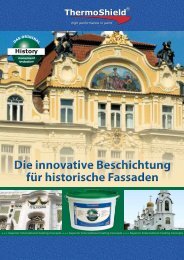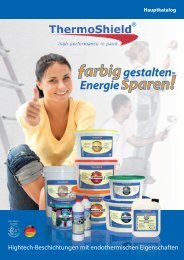Create successful ePaper yourself
Turn your PDF publications into a flip-book with our unique Google optimized e-Paper software.
high performance in paint<br />
Thermal bridges<br />
A thermal bridge (often colloquially referred to as a cold bridge) is an area in parts of a building,<br />
through which the heat is transported outwards faster than through the adjacent components.<br />
A distinction is constructive and geometric thermal bridges. Constructive thermal bridges<br />
caused by constructions with materials of different thermal conductivity. Examples include<br />
reinforced concrete slabs attached to exterior walls, I-beam or radiator niches.<br />
Geometric thermal bridges arise if the inner surface of the outer surface is uneven, for example<br />
by projections or corners in an otherwise homogeneous component. Example is the house<br />
outside corner at the increasingly cold outer wall influences the warm inner wall portion at<br />
different percentages.<br />
Source: Wikipedia)<br />
Thermal Streaking or “Ghosting”<br />
Deposits of dark particles (black dust) on interior walls. In severe cases, the impression of<br />
sooting arises. The causes are not yet clear. Since this effect is amplified in the heating season,<br />
it is assumed that this is deposits of low volatile organic compounds (so-called plasticizers) are<br />
swirled and settle on walls and ceilings and caused by other issuers by convection currents.<br />
(Source: SICC Coatings GmbH)<br />
Transmission heat transport /<br />
Transmission losses<br />
Transport of (heat) energy between regions of different temperature due to thermal<br />
conduction in solids as in a wall (the molecules repel each other). The heat current always flows<br />
from areas with higher energy to areas with lower energy, for example: from warm to cold.<br />
The energy loss in this transport is also called heat transmission losses. These are determined by<br />
the heat transfer coefficiency. Other forms of energy transfer are convection and radiation.<br />
Reduced radiation on the facade reduces the overall transmission.<br />
(Source: SICC Coatings GmbH)<br />
Capillary drying<br />
Capillarity refers to the behavior of liquids in passageways, also called capillaries. If the adhesive<br />
forces between the liquid and the capillary wall is greater than the cohesive forces between the<br />
molecules of the liquid, the liquid "crawls" into the capillaries, even against gravity and even<br />
more, the more narrowly the capillaries are/become. If liquid through this process from the<br />
material (for example masonry) transported to the surface where it can evaporate, a person<br />
calls this capillary drying. The exterior plaster has a finer capillary system compared to masonry.<br />
The <strong>ThermoShield</strong>®-membrane has a finer capillary than the external plaster. These directed<br />
transports result in drier walls.<br />
Source: SICC Coatings GmbH)<br />
Endothermic properties<br />
Is the synonym for processes, which occur within <strong>ThermoShield</strong>®-coatings and vary depending<br />
on external factors such as temperature and humidity. Endotherm means in chemistry: energy<br />
is absorbed, resp. gained.<br />
(Source: SICC Coatings GmbH)<br />
the Bright reference limit<br />
The bright reference value is the degree of reflection of a particular hue between black = 0 and<br />
white = 100. His value indicates how far the color in question is removed from the black or<br />
white point in its brightness. In color fans the bright reference value is shown next to the color<br />
number. The crucial point to the lightness value is neither gloss nor the binder used, but only<br />
the type and level of color pigmentation.<br />
(Source: SICC Coatings GmbH)<br />
Thermo-ceramic membrane<br />
Is a collective term for a high-quality dispersion enriched with only 20-120-micron ceramic<br />
hollow spheres and activators, which - in conjunction with monolithic masonry - trigger<br />
mutually dependent complex processes of building physics. These have a positive effect on the<br />
moisture and heat transport and thus on the energy balance of the building.<br />
(Source: SICC Coatings GmbH)<br />
Explanation of Terms<br />
29











